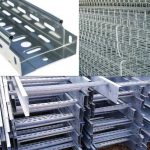The cable gland is also called cable strain relief, cable glands are defined as mechanical cable entry which means they are used to attach the electrical cables securely to protect the equipment. Glands are common features of assemblies and electrical Power structures used to mount the wires and protect the cables. These devices are widely available depending on the design, applications, and environmental conditions. iEngineering is here to give you answers to some of the most common questions about cable glands. Read on to learn answers, to what cable glands mean. What are the different types of cable glands? How to choose cable glands according to your application?
A cable gland is also called a cable connector, cable fitting device, cable strain relief, or cord grip.
The main functions of the cable gland are to act as a sealing and ending device to ensure the protection of electrical equipment and enclosures, cable glands are used to protect the electrical power cables from environmental protection- by sealing the outer cable sheath, excluding the dust and moisture from the electrical or instrument enclosure.
What are the uses of cable glands?
- Strain relief: cable glands are also referred to as cable strain relief, as this connection provides strain relief and resistance against the turning, twisting, and pulling forces to prevent disconnection in large electrical power systems. The cord grip secures the cable to the system at a fixed angle.
- Connection protection: cable glands cover the outer cable sheath, protecting the electrical enclosure from dust, dirt, and moisture, and other environmental hazards that will help you to improve the installation functionality.
Types of Cable glands
Cable glands come with many applications depending on your requirements, there are various types of cable glands available. They are differentiated based on Material, Functions, Shapes, Threads, Compression, types of applications, and Waterproof degrees. The most common differentiation depends on their material, so cable glands have two main types.
- Metal Cable glands
- Plastic Cable glands
Metal Cable glands: Metallic cable glands are used in a broad range of applications and feature materials like stainless steel, aluminum, and nickel-plated brass.

Advantages
- long-term durability.
- Rigid stability.
- Electrical and thermal conductivity are some of the key advantages of this material.
- Metal cable glands can be used where chemical stability and mechanical strength are required.
Plastic Cable Glands: Plastic cable glands are mostly made up of polyamide or nylon and typically come in claw and seal designs making them highly acceptable. Plastics are also resistant to salt water, weak acids, and grease, making them a great choice for various industries.

Advantages
- Flexibility and resistance to various corrosive elements.
- A seal maintains a connection, which keeps dust and moisture out.
Depending on applications
- Marine or Waterproof cable glands
- Electromagnetic capability cable grips
- Electrical cable glands
- Firestop cable gland
Depending on the Armor capability
- Armored: These types of cable glands are frequently designed with an extra layer of protection for damage prevention, these cable glands are mostly acceptable where the area may be of exposure to an increased threat of mechanical damage. Armoring often comes in a single wire, braided wire, or double steel tape.
- Unarmored: Unarmored cables are more basic in design than armored cables and do not have added mechanical protection. These appear in fixed installations without a substantial risk of mechanical damage.
How to choose a cable gland?
As there are so many different cable connector types and designs to examine through, still it can be challenging to determine which types of cable glad to use for the specific application and what features we should keep in our mind to select the correct cable glands.
Below are some key points to help you to choose the correct cable glands for your need.
- The first thing that needs to be kept in mind is what types of electrical cable and system – electrical power system, any industry, telecommunication, etc.
- What type of installation- domestic, commercial, industrial?
- Environmental condition- indoor or outdoor?
- What would be the temperature and how much will they change?
- Will the cable gland be exposed to moisture, dust, dirt, or corrosive elements?
- Is there any other environmental condition that will affect like an explosive, corrosive atmosphere?
- What is the cable size, and does it feature any armoring? If it does have armor, what type?
- Once you have narrowed down your cable gland options to suit your application’s needs, you can then make a final decision based on cost.
For more information and enquiries please contact us at – shila@iengaust.com.au
#mechanicalprotection #supportforcables #protecttheelectricaldevice





